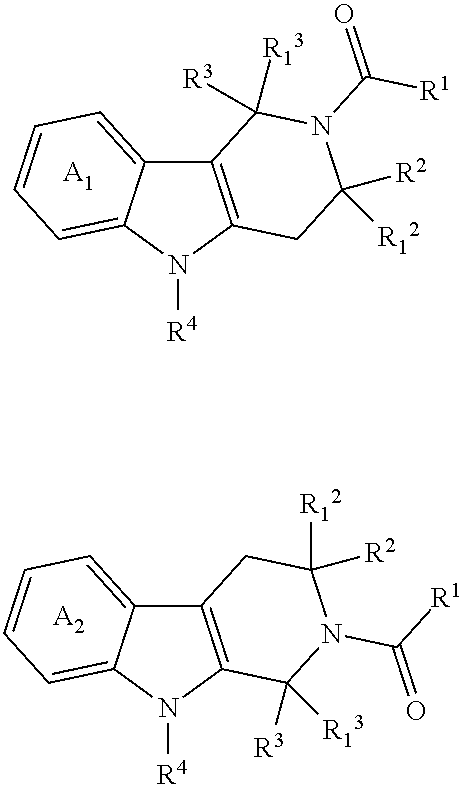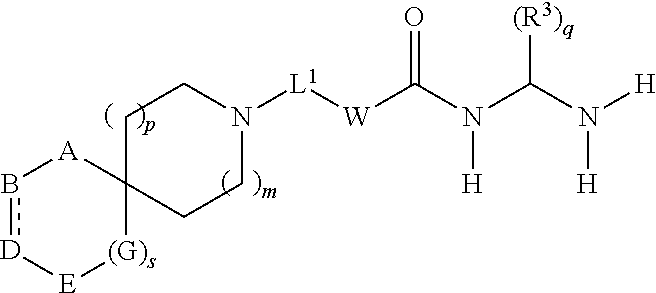Spirocyclic derivatives as histone deacetylase inhibitors
a histone deacetylase and spirocyclic derivative technology, applied in the field of histone deacetylase inhibitors, can solve the problems of poor potency, limited clinical benefits, poor pharmacokinetic properties,
- Summary
- Abstract
- Description
- Claims
- Application Information
AI Technical Summary
Benefits of technology
Problems solved by technology
Method used
Image
Examples
example 1
(E)-3-{4-oxo-spiro[chromane-2,4′-piperidine]-6-yl}-N-hydroxy-acrylamide
[0340]
[0341]Step A
[0342]NaOH (160 mg, 4 mmol) in H2O (2 ml) was added to a suspension of (E)-3-{1′-tert-butoxycarbonyl-4-oxo-spiro[chromane-2,4′-piperidine]-6-yl}-acrylic acid methyl ester (462 mg, 1.15 mmol, Intermediate 1, Step B) in MeOH (6 ml). The mixture was stirred at 50° C. After 2 h, MeOH was evaporated and the pH of the aqueous phase was adjusted with 1 M HCl to a pH value of 5. The resulting suspension was extracted with DCM, the organic phase dried over Na2SO4 and concentrated to give (E)-3-{1′-tert-butoxycarbonyl-4-oxo-spiro[chromane-2,4′-piperidine]-6-yl}-acrylic acid (410 mg) as a white solid.
[0343]Y=92%
[0344]LC-MS: Method A, rt=5.2 min; (ES+) MNa+: 409.9
[0345]1H-NMR (CDCl3) δ (ppm): 8.05 (d, J=2.0 Hz, 1H), 7.70 (m, 2H), 7.04 (d, J=8.8 Hz, 1H), 6.39 (d, J=16.0 Hz, 1H), 3.88 (m, 2H), 3.22 (m, 2H), 2.75 (s, 2H), 1.61 (m, 4H), 1.50 (s, 9H).
[0346]Step B
[0347]A solution of (E)-3-{1′-tert-butoxycarbonyl-...
example 2
(E)-3-{1′-Benzyl-4-oxo-spiro[chromane-2,4′-piperidine]-6-yl}-N-hydroxy-acrylamide
[0356]
[0357]Step A
[0358]A suspension of (E)-3-{4-oxo-spiro[chromane-2,4′-piperidine]-6-yl}-acrylic acid methyl ester (451 mg, 1.34 mmol, Intermediate 1) in DCM (12 ml) was treated with TEA (0.42 ml, 3 mmol) and benzyl bromide (0.54 ml, 4.5 mmol), and stirred at RT for 5 h. The mixture was washed with water, the pH value was adjusted to 5 with a 0.5 M HCl, then dried and concentrated. The crude residue was purified by column chromatography (eluent: DCM / MeOH 95:5) to give (E)-3-{1′-benzyl-4-oxo-spiro[chromane-2,4′-piperidine]-6-yl}-acrylic acid methyl ester (440 mg) as a light yellow solid.
[0359]Y=84%
[0360]LC-MS: Method A, rt=4.1 min; (ES+) 2MNa+: 805.5
[0361]1H-NMR (CDCl3) δ (ppm): 8.02 (d, J=2.0 Hz, 1H), 7.65 (m, 2H), 7.52 (m, 2H), 7.47 (m, 3H), 7.01 (d, J=9.2 Hz, 1H), 6.38 (d, J=16.0 Hz, 1H), 3.80 (s, 3H), 3.55 (m, 2H), 2.76 (m, 2H), 2.62 (m, 2H), 2.46 (m, 2H), 2.04 (m, 2H), 1.77 (m, 2H), 1.57 (m, 2H).
[...
example 3
(E)-3-{1′-Acetyl-4-oxo-spiro[chromane-2,4′-piperidine]-6-yl}-N-hydroxy-acrylamide
[0377]
[0378](E)-3-{1′-Acetyl-4-oxo-spiro[chromane-2,4′-piperidine]-6-yl}-acrylic acid methyl ester was obtained starting from (E)-3-{4-oxo-spiro[chromane-2,4′-piperidine]-6-yl}-acrylic acid methyl ester (301 mg, 1 mmol, Intermediate 1) and acetyl chloride, according to the procedure described in Example 2, Step A, giving a white solid (330 mg, 96%). The methyl ester group was hydrolyzed with NaOH following the procedure described in Example 1, Step A, giving (E)-3-{1-acetyl-4-oxo-spiro[chromane-2,4′-piperidine]-6-yl}-acrylic acid as a white solid (205 mg, 67%). The resulting product was treated with NH2OTHP according to the procedure described in Example 1, Step B, giving (E)-3-{1-acetyl-4-oxo-spiro[chromane-2,4′-piperidine]-6-yl}-N-(tetrahydro-pyran-2-yloxy)-acrylamide as a yellow solid (164 mg, 62%). Finally, removal of the THP protecting group following the procedure described in Example 2, Step D ga...
PUM
 Login to View More
Login to View More Abstract
Description
Claims
Application Information
 Login to View More
Login to View More - R&D
- Intellectual Property
- Life Sciences
- Materials
- Tech Scout
- Unparalleled Data Quality
- Higher Quality Content
- 60% Fewer Hallucinations
Browse by: Latest US Patents, China's latest patents, Technical Efficacy Thesaurus, Application Domain, Technology Topic, Popular Technical Reports.
© 2025 PatSnap. All rights reserved.Legal|Privacy policy|Modern Slavery Act Transparency Statement|Sitemap|About US| Contact US: help@patsnap.com



